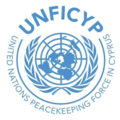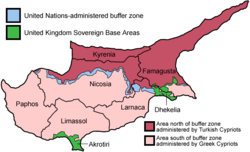
Back الخط الأخضر (قبرص) Arabic Yaşıl xətt (Kipr) Azerbaijani Зелена линия (Кипър) Bulgarian Línia Verda (Xipre) Catalan Nárazníková zóna OSN (Kypr) Czech UN-Pufferzone (Zypern) German Πράσινη Γραμμή Greek Verda Linio (Kipro) Esperanto Línea Verde (Chipre) Spanish خط آتیلا Persian
This article needs additional citations for verification. (July 2012) |
 | |
 The UN Buffer Zone is shown in light blue on the map. | |
| Formation | 4 March 1964 |
|---|---|
| Type | Demilitarized zone |
Special Representative | Elizabeth Spehar |
Commander | Maj. Gen. Ingrid Margrethe Gjerde |
Parent organization | United Nations Peacekeeping Force in Cyprus |
The United Nations Buffer Zone in Cyprus is a demilitarized zone, patrolled by the United Nations Peacekeeping Force in Cyprus (UNFICYP), that was established on 4 March 1964. It was extended on 9 August after the Battle of Tillyria and extended again in 1974 after the ceasefire of 16 August 1974, following the Turkish invasion of Cyprus and the de facto partition of the island into the area controlled by the Republic of Cyprus (excluding the British Sovereign Base Areas) and the largely unrecognized Turkish Republic of Northern Cyprus in the north. The zone, also known as the Green Line (Greek: Πράσινη Γραμμή, Prasini Grammi; Turkish: Yeşil Hat), stretches for 180 kilometres (112 miles) from Paralimni in the east to Kato Pyrgos in the west, where a separate section surrounds Kokkina.
The dividing line is also referred to as the Attila Line,[1] named after Turkey's 1974 military intervention, codenamed Operation Attila. The Turkish army has built a barrier on the zone's northern side, consisting mainly of barbed-wire fencing, concrete wall segments, watchtowers, anti-tank ditches, and minefields. The zone cuts through the centre of Nicosia, separating the city into southern and northern sections. In total, it spans an area of 346 square kilometres (134 sq mi), varying in width from less than 20 metres (66 ft) to more than 7 kilometres (4.3 mi).[2][3][4] After the fall of the Berlin Wall in 1989, Nicosia remains the last divided capital in Europe.[5][6] Some 10,000 people live in several villages and work on farms located within the zone; the village of Pyla is famous for being one of the few remaining villages in Cyprus where Greek and Turkish Cypriots still live side by side. Other villages are Deneia, Athienou, and Troulloi. Some areas are untouched by human interference and have remained a safe haven for flora and fauna.[3]
- ^ Oxford References: Attila Line
- ^ "UNFICYP Background". UN.org. UN Peacekeeping. Retrieved 10 March 2016.
- ^ a b "About the Buffer Zone". unficyp.unmissions.org. United Nations Peacekeeping Force in Cyprus. 20 November 2015. Retrieved 10 March 2016.
- ^ Konyalian, Claudia. "Biodiversity in Cyprus 346 square kilometres Buffer Zone". undp.org. United Nations Development Programme. Archived from the original on 3 February 2018. Retrieved 10 March 2016.
- ^ Associated Press: 30 years after the Berlin Wall, Cyprus' division endures
- ^ Independent.co.uk: Europe's other wall: How militarised barrier continues to divide Cyprus, 30 years after Berlin's came down